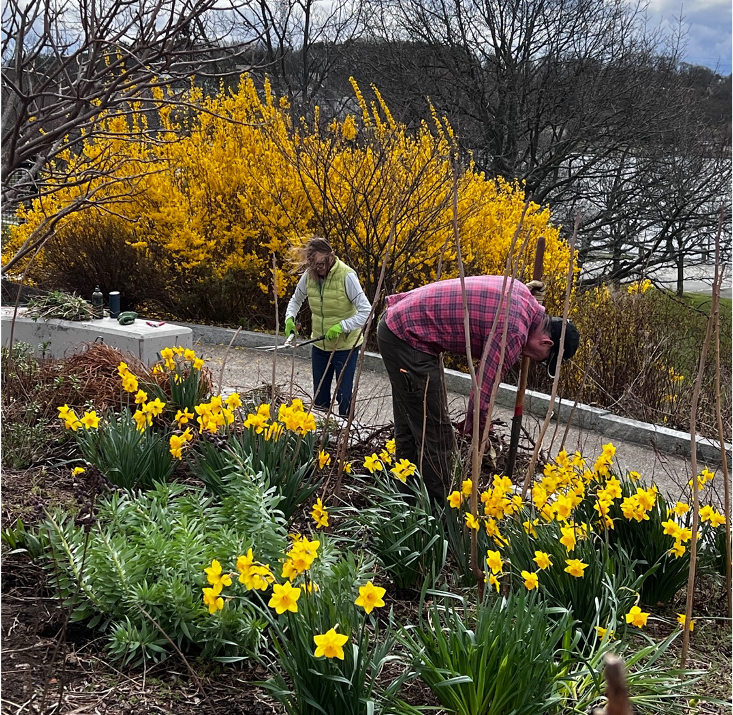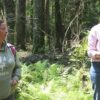‘It pays off to do all this work because the community enjoys it’
Originally published by The Providence Eye, a publication partner of Ocean State Stories.
By Anna Browder
With the rise of industrialization and the growth of cities in the nineteenth century, the natural outdoors was increasingly seen as healthy, even curative. Without great expanses of nature, cities developed public gardens- beautiful green spaces, for the public’s benefit, some of the most famous designed by the firm of Frederick Olmstead. According to the Trust for Public Land, 99% of Providence is within a ten-minute walk to a public park, well above the median average for 100 of the most populated cities in the US. Even so, the public green space in Providence is only ten percent of the city’s total land area.
Providence’s greatest green space is Roger Williams Park. Providence’s 120 parks, however, tended by the Parks Department, include traditional parks, athletic fields, basketball courts, playgrounds, conservation areas, walking/running tracks and trails, non-traditional recreation areas (skateboard features, bike tracks, parkour), dog parks, cemeteries, and an ice rink. All are spaces in need of constant maintenance themselves, not to mention the programming provided to encourage use. Volunteers complement the work that the Parks Department does daily.
Some gardens are created for an appreciation of beauty alone, a credit to the public-spirited volunteers who helped to plan and maintain them, along side the Parks Department. Among them is The Providence Station Park, in the center of the city, surrounding the train station and extending to the roof of the parking garage at the Amtrak Station.
The gardens were designed by Ilya Iskhakov, a Rhode Island School of Design-educated landscape architect, now working for the city’s Parks Department. They encompass approximately 15,000 square feet and are now in late spring bloom. They were planted by, and are actively maintained by, volunteers, working in conjunction with the Parks Department.
Iskhakov intended that this garden address “the transitions between vehicular and pedestrian circulations because you have people exiting the station, and vehicles are picking them up. So you need to slow down the traffic, allow people to move. . .so the beds themselves were designed to house ornamental vegetation and were more like buffer zones. The beds weren’t developed to be… used actively by people.” There’s no playground, just beauty and admiration.
For the site, he chose chiefly native plants: “I wanted to stress inclusivity and so, while dominant plants in this park are equal to the Rhode Island natives and we want to highlight them, there are a lot of plants that have made it in there on their own, whether they were already part of the seed bank and the soil, or they volunteered after the fact. . .It helps us to achieve sustainable maintenance goals because it would be foolish to try to… eradicate one species over the other. . .it … isn’t lost on me… that that relates to the beautiful urban fabric of Providence.”

The India Point Park Pedestrian Bridge
Another park that benefits significantly from volunteers is the bridge over Highway I-195 that opened in 2008, the India Point Park Pedestrian Bridge, connecting Fox Point to the park. The bridge is six times wider than the one it replaced, lined with large planters on each side and followed by terraced gardens leading to the park below.
Nidia Schuhmacher, who moved to Providence in 2013 with her family, and who teaches Spanish at Brown University, frequently walked the pedestrian bridge to India Point Park, wondering why the contents of the extensive planters were so neglected. She eventually saw a notice for volunteers to work on the bridge and discovered how much influence volunteers had on the health of plants and parkgoers. She joined the Friends of India Point Park, founded in 2000 by Marjorie Powning and David Riley.
She remembers meeting with Graham Gardner, who had been involved in the landscaping and design of the gardens. “We sat with him on the pedestrian bridge and he gave us all the blueprints of the bridge and the ramps and the list of all the plants they had planted, and why the irrigation was not working.” She became a dedicated volunteer but notes the difficulties of working as a volunteer. During COVID, many people wanted to combine working outdoors with socializing, all for a good cause. One time twenty-two people showed up to work. After COVID, however, a list of 80 volunteers, when contacted, might produce only a handful of workers.
Other challenges involved achieving timing and agreement with the Parks Department on what needed to be done. “I had requested the Parks Department to clean the drains of all the mulch and soil that washes down from the hills and also through the tunnel which is like a corridor of wind, and when it is stormy, over the winter, it accumulates and ends up in that drain. They hadn’t done it, so we had to do it ourselves.” At the same time, she acknowledges that the Parks Department has one hundred twenty parks to tend to and that “ they are stretched to the maximum.” In addition to working with the city’s Parks Department, the bridge volunteers dealt also with the Rhode Island Department of Transportation which owns the bridge. At one point, Schuhmacher remembers that RIDOT shaved off all plants extending above the planters- “a disaster.” Working successfully with governmental agencies is crucial, and Schuhmacher notes that “finally, I think this summer, things are good.”
Schuhmacher says volunteers “are following the school of leaving things on the ground. We don’t rake. That’s another thing we’ve been trying to struggle with the Parks Department over, because they come and they want to clean everything, and rake everything. We just remove, you know, when there are lumps of heavy things that we know are damaging, but, in general, that becomes compost.” As of now, “we’ve planted thousands of plants, all native. . . we wanted this to be a native garden with pollinators, a place really that people can be proud of.” She keeps a careful record of all plants.
When Schuhmacher and her husband walk to the park, they are often weeding as they go. Bikers riding by express their appreciation. “It pays off to do all this work because the community enjoys it. “And it’s so encouraging, it lifts up their spirit. . .this view of the water, I mean, how many parks do have this view? It’s a wonderful, wonderful park.”
Bikers riding by express their appreciation. One said, “I learned I wanted to put plants in my garden, like here.” Schuhmacher said, “That’s what the garden is for. Go to our website, we are in fact about to revamp it and we have an inventory of the plants. We need to upload it- that’s one of the projects we have for this year.” What she says applies to all three public gardens; they are deliberate demonstrations of the beauty of native plants which visitors can choose to plant, themselves.
India Point Park is due to undergo construction, with improvements scheduled for the promenade and the playground. “I agree with some things and not with others. I am afraid of building too much. . .I would like it to remain more of a wild space.” She acknowledges that “in the end it’s the Parks Department, the administration of parks who will make decisions. . . I hope it’s good.”
The Pollinator Garden
Tucked in the North Burial Ground on North Main Street is yet another garden planned and created by volunteers; two women wanted a sunny place to develop a pollinator garden of native plants. Martha Fraenkel and Margaret Brookner took over a plot, now 75 by 35 feet, which had been planted with shrubs and heavily mulched over a weed barrier, in a strip of land called Randall Park, between North Main Street and the cemetery, which belongs to the Providence Park Department. It’s a great location where no graves will ever be sited.
Of establishing the garden, Fraenkel says, “for years and years nothing grew there. Eventually some of the grass from the lawns seeded itself, but no native herbaceous material. So, we thought we could plant something native for the pollinators, for the bees. We got a grant from the RI Wild Plant Society, went to Blue Moon Nursery, and bought about 30 plants, and I would say it was successful. Some things were more aggressive than others, some things don’t like the droughtiness of some summers, and some things were attractive to rabbits, like asters. We created a habitat for rabbits, and the rabbits started to live in this patch. The showy goldenrod took over. It’s wild. Where the goldenrod, asters, and coneflowers took off, it looks like a garden, but the rest of it is messy, there’s grass growing around the plants, and we don’t weed it.”

Because the garden is in the middle of a grassy field, which is mowed by the Parks Department, it is unfenced, surrounded by a berm of wood chips to protect it. Its future is unclear, its existence dependent on the work of the two women who established it, but it is uncertain whether the Parks Department will include it in its plan for Randall Park, which is being developed.
Iskhakov, creator of the Providence Station Park, is adamant about the need for public gardens to be developed and maintained. The creation of parks – the institution and its staff – is “actively addressing climate change and climate-related challenges through our construction projects and landscape management routines that center around sustainability and ecology, which work with and restore natural systems.” Climate change is as much a part of the way nature is perceived today as the development of a romantic view of nature was in the nineteenth century. Both are reactions to the cumulative effects of industrialization.
“Greenspace” has been recognized as a key factor in measuring “mental health and well-being. Individuals have less mental distress, less anxiety and depression, greater well-being and healthier cortisol profiles when living in urban areas with more greenspace compared with less greenspace. Large differences in disease prevalence are reported when comparing residents of very green and less green settings, even after controlling for socioeconomic status.” Greenspace, it would seem, helps to buffer the stress of urban living.
As spaces in cities become increasingly commodified, designed to serve the public that can pay, the very existence of public space is “a physical manifestation of the democratic system,” according to Iskhakov. “A public park is where people of all walks of life and of any means are free to be and enjoy. As such, these places need to be beautiful, safe and accessible. As publicly owned land that is directly linked to natural systems, these spaces also need to be safeguarded and protected and made resilient and adaptable so that they can meet the strenuous demands of our society, including challenges presented by climate change while providing ecological services, and in doing so serving as ambassadors or… ‘influencers’ of how private spaces could look and operate.”
Each of these three gardens needs volunteers who love plants and are interested in caring for them. Some volunteers will be experienced gardeners, but in each garden, volunteers receive training, direction, and supervision, as well as tools, gloves, and trash bags. During the spring, beds need to be cleaned, old stalks removed, and shrubs pruned. An effort is made to remove weed plants before they go to seed. Maintenance continues throughout the summer, and often new plants are added. Volunteering is a delightful way to be out in urban nature, make new acquaintances, and learn new skills.

Volunteers can check with parks nearest them, many of which have websites or Friends groups. Among other places to investigate: Southside Community Land Trust and Roger Williams Park for community gardens, Providence Community Tree Keepers, to become a volunteer street tree pruner, and What Cheer Flower Farm, which grows flowers to give away. Groups of volunteers may apply for grants to beautify communities from Bloom Rhode Island.
Editor’s note: Anna Browder is retired from teaching science in the Lower School at Lincoln School for Girls. She used the adjacent Blackstone Park as an outdoor classroom while teaching, and later became involved in working to preserve the park. Eventually she added Blackstone Boulevard to her park work, helping raise funds for planting new trees. More recently she has volunteered at the Bridge Garden helping identify and remove invasive species.






